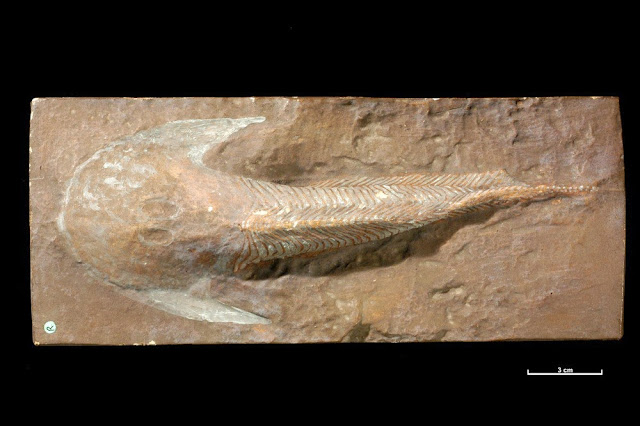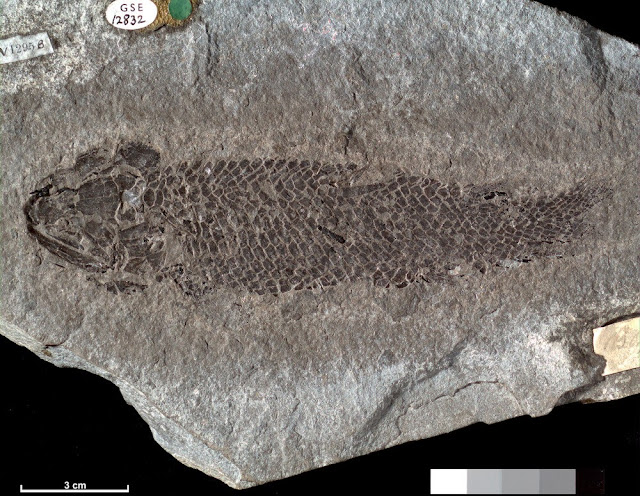 |
| BGS Image ID: P549484 |
Thrissops was a member of the more advanced ray-finned fish, an early teleost. It lived in the seas of many places in Europe and fossils have been found in Jurassic and Cretaceous sediments of England, France and Germany. There may be one group of living fish related to Thrissops, the freshwater 'bony tongue' such as the pirarucu which lives in the rivers of South America. Thrissops grew up to about 60 cm. in length and once swam in the late Jurassic seas of southern England, about 145 million years ago. Although not seen in the specimen illustrated, Thrissops had a large symmetrical tail which enabled the fish to swim rapidly. It had small pelvic fins, but long anal fins, which were used to stabilise it. The pectoral fins were large as can be seen in the photograph. Fish are cold-blooded vertebrates with a braincase, fins for swimming and gills to take oxygen from the water (although some also have lungs). They therefore differ from other aquatic creatures like invertebrate molluscs or crabs; amphibians and reptiles, which have lungs and limbs rather than gills and fins; and whales and dolphins which are warm-blooded mammals. Fish are the first vertebrates, having evolved during the early Cambrian over 500 million years ago.
.jpg) |
| BGS Image ID: P549485 |
Lobe-finned fish like coelocanths are occasionally found in the late Cretaceous (about 70 million years old) Chalk of Britain and in eastern Europe. However, coelocanths then seemed to disappear from the fossil record, and it was assumed that they had become extinct. However, in 1938 a living representative was found and they have since been found living off the Comoro Islands, Indian Ocean, and off Indonesia. Macropoma grew to about half a metre long. It had a deep body and a bulbous, 3-lobed tail. Its teeth are confined to the very front of the jaw. It had two dorsal fins, a pair of pectoral fins on its side and pelvic fins mid-way along on the underside of the body. Macropoma scales are very thin, ovoid plates of fibrous bone, enamelled on the outer surface. Fish are cold-blooded vertebrates with a braincase, fins for swimming and gills to take oxygen from the water (although some also have lungs). They therefore differ from other aquatic creatures like invertebrate molluscs or crabs; amphibians and reptiles, which have lungs and limbs rather than gills and fins; and whales and dolphins which are warm-blooded mammals. Fish are the first vertebrates, having evolved during the early Cambrian over 500 million years ago.
 |
| BGS Image ID: P521130 |
Cephalaspis lyelli is a jawless fish; a member of the Ostracoderms which were armoured with bony plates and scales. British Geological Survey Biostratigraphy Collection number GSM 5107. Cast of Lectotype. They occurred mainly in fresh and brackish water and were most abundant in the Lower Old Red Sandstone Devonian. Cephalaspis is one of the best known ostracoderms with the head covered by a rigid bony shield and the rest of the body by elongated scales. A pair of fins lie just behind the head shield which has the depressed shape of a bottom dweller. Cephalaspis is thought to have lived in fresh-water pools or streams feeding on organic material filtered in the gill pouches from bottom sediments. Figd. Agassig, Rech, Poiss. Foss. 2. 1838, pl. 1, fig.2, and Lankester, Mon. Pal. Soc. 1868, O.R.S. Fishes. Pl. VIII, fig. 1, & Stensio, Ceph. Great Britain 1932 B.M.(N.H.) pub. Text fig. 40, p.121. Cited Lankester, as before, p 44, and Stensio as before .
 |
| BGS Image ID: P521200 |
Osteolepis macrolepidotus is a crossopterygian fish from the Old Red Sandstone (Devonian). British Geological Survey Biostratigraphy Collection number GSE 12832. The lobe-finned fish distinguised by paired fins supported by scale-covered fleshy lobes and axial bony skeleton, and nostrils in the upper mouth include two groups, the lungfish such as Dipterus and the crossopterygians such as Osteolepis and Holoptychius. Crossopterygians were noted for their sharp pointed grasping teeth with vertically-grooved surface giving a labyrinthodont form well suited to a voracious predator such as Osteolepis. The evolution of the lobe-finned fish was one of the most important steps in the evolution of the vertebrates. Some features of Osteolepis are found in the labyrinthodont amphibians such as the ichthyostegids.
Posted by Bob McIntosh.
No comments:
Post a Comment